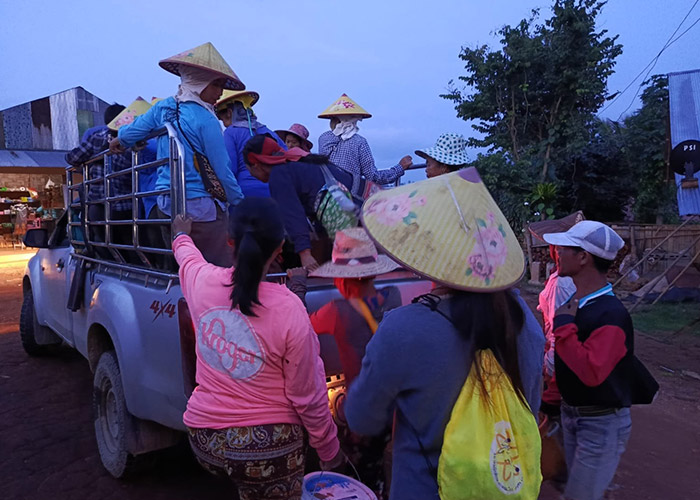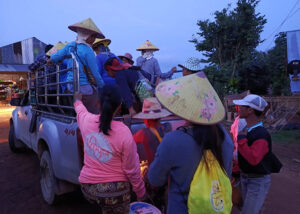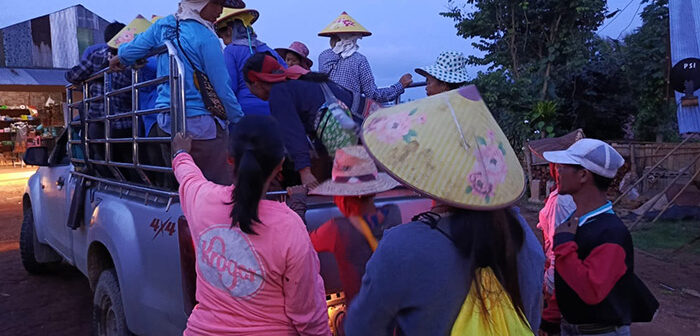

Refugees doing farm labor in Northern Thailand, courtesy of Antonio Graceffo.
By Antonio Graceffo
“After the coup, every night became loud,” said 17-year-old Jeffrey, a member of the Lisu ethnic group, referring to the airstrikes and artillery barrages devastating Burma’s civilian population. “The situation grew uglier by the day. We stayed quietly in the house, trying not to attract attention. It is no longer a safe place with so much chaos.”
Fearing he would be forcibly conscripted into the army, Jeffrey’s family brought him to Thailand, where he is now part of a growing refugee community.
Currently, approximately 3.5 million people are displaced within Burma, a figure projected to rise to 4.5 million by the end of the year. Additionally, an estimated three to four million Burmese have sought refuge across the border in Thailand. More than one million Rohingya are living in refugee camps in Bangladesh, with many others resettled in third countries. Altogether, at least 15% of Burma’s population has been forced from their homes.
Since gaining independence from Britain in 1948, Burma’s military governments have marginalised the country’s 135 ethnic minorities, excluding them from political representation while exploiting the resource-rich ethnic states bordering Thailand and China. The Karen ethnic group was the first to take up arms that same year, demanding independence. Over time, most ethnic groups formed ethnic armed organisations to fight for autonomy or independence, leading to a complex and shifting landscape of resistance. While some groups have collapsed permanently, others have reemerged or rebranded, with an estimated 120 armed groups currently active.
The resulting displacement crisis stems from a combination of factors: military violence, political oppression, ethnic conflicts, economic collapse, humanitarian crises, forced conscription, inter-ethnic clashes, and the heavy burdens of double and triple taxation imposed by both government forces and competing ethnic groups. These overlapping challenges continue to uproot millions, creating one of the world’s most protracted humanitarian crises.
Shan State is home to several of the largest and most well-armed groups, intensifying the suffering of its civilian population. In Ban Zing, a sub-township of Merng Nong in Loi Lem District, southern Shan State, three armies operate: the Restoration Council of Shan State (RCSS/SSA), the Shan State Progress Party (SSPP/SSA), and the Burma Army. Recently, the Burma Army issued a conscription law, and the Shan armies followed with their own forced recruitment announcements.
“The armies explained to local residents that everyone aged 18 to 35, or up to 45 depending on health, must serve in an army, but you can choose which Shan army to join. For example, if you join the RCSS/SSA, you won’t have to join the SSPP/SSA because we are all the same,” said Nang Kham Khin, a 40-year-old Shan woman living in Ban Zing. The same is not true of the Burma Army, which would severely punish families whose children joined a resistance army, whether willingly or unwillingly.
“They also warned that anyone who tries to run away to Thailand will face consequences—their parents will be punished, and their houses, farms, and belongings will be confiscated,” she said.
The situation has become dire for civilians like Nang. “All the roads in the country are now lined with checkpoints,” she said. “If the armies see young people, both male and female, of conscription age, they will grab them on the spot.”
In the past, those who were too old to serve were sent back. Now, some armies are so desperate for recruits that they are even retaining individuals in their fifties and sixties to stand guard and perform other menial support tasks. “The only way to get to Thailand is to walk through the jungle, but it’s very dangerous, so now I’m stuck with no way to get out,” said Nang.
Daily life has become nearly impossible in Ban Zing. “It’s very hard to get petrol and food, and everything is extremely expensive. I think we will soon starve to death,” Nang lamented. “We can’t even leave town to work. At the end of February, 15 young people from Ban Zing tried to reach Thailand through the jungle, but when they arrived at the Thai-Burma border, Thai troops stopped them and sent them back. Nobody has heard from them since.”
The restrictions extend to communication as well. Nang explained, “It’s very hard to contact anyone outside. If the armies catch us trying, we will be punished and jailed.”
Sai Kungdala, a 48-year-old Shan man, and his 45-year-old wife, Nang Mya, fled Nam Sang in Southern Shan State. For the past few months, they have been living in Wiang Haeng District, Thailand, an area now home to a majority Shan population composed of refugees. Many, like Sai Kungdala, lack Thai ID cards, visas, or work and residence permits.
He described how his family managed to survive back in Burma. “My wife grew vegetables and sold them each morning. My older child, who is 17, worked with me, while my younger child, 15, helped my wife with the growing and selling. My children have never been to school because they had to help support the family to ensure we had enough food,” he said, adding that the school was too far from their village and there was no transportation. “Some families could afford a Chinese motorbike for their children to get to school, but I couldn’t afford a motorbike or even a bicycle for mine.”
Before the military takeover, Sai Kungdala and his family could sustain themselves with their combined earnings. “The maximum daily wage was 8,000 to 10,000 kyat (less than $5 USD), but for heavy labor, it was 15,000. Together, my son and I earned 20,000 kyat a day, while my wife and daughter made another 10,000 to 15,000 kyat. That was enough to support our family,” he recalled.
However, the military coup in 2021 drastically changed their lives, as families across Burma grappled with soaring inflation and a collapsing currency. “After the takeover, the price of goods doubled, but our daily wages stayed the same. Sometimes, the employer paid us half in yaba pills (methamphetamine) and half in cash,” he recounted.
Many ethnic armed organisations and the Burmese military produce and sell yaba (methamphetamines) to fund their operations. In ethnic areas, locals are often coerced into drug production and distribution, though some engage willingly due to a lack of alternative income sources.
By 2024, wages were paid entirely in yaba, which the family had to resell to survive. “The price of yaba was very low, only 200 kyat per pill, and it was hard to sell because everyone already had yaba,” Sai Kungdala said.
The situation worsened, with local militias imposing further hardships. “They frequently forced residents to attend military training and serve as guards. Life became increasingly difficult, and sometimes my family didn’t have enough food to eat,” Sai Kungdala said. The cost of basic goods became unbearable. “One egg cost 500 kyat, about 23 cents. To afford just one egg, we had to sell 2.5 pills of yaba.”
“In Thailand, we receive our daily labor wages in cash, which is different from my hometown,” said Sai Kungdala. “Yaba is illegal here, and no one uses it. I think the system here is better.”
Sai Kungdala explained that while their daily earnings are enough to buy food, finding consistent work remains a challenge. Without a work permit or ID card, he and his family are forced to work illegally as low-paid laborers, and even at this subsistence level, employment opportunities are sporadic. “This season has been good for us, as we often work on garlic farms. Sometimes, my wife, my two children, and I earn over a thousand baht per day (about $30 USD), which is enough for my family to survive. We spend some of our money and save the rest, as we need to pay back the debt we owe to friends for the transportation costs to Thailand.” The money paid to human traffickers to reach Thailand can be as high as $700 USD, an exorbitant sum for most refugees. “I think if we have a chance to work for about five months, we can pay back the money we borrowed.”
Despite the challenges, Sai Kungdala expressed a preference for Thailand over returning to Burma. “I think Thailand is better than Burma, but we need to be careful about the police, as we don’t have ID cards or work permits,” he said. Concluding with conviction, Sai Kungdala added, “As for me, I don’t want to go back, even if Burma becomes peaceful. I will live in Thailand for the rest of my life.”
Whether they hope to return to Burma someday or remain in Thailand, the vast majority of Burmese refugees in Thailand are undocumented. They choose to live with the constant fear of deportation rather than endure the daily threats of violence, loss of freedom, and starvation in war-torn Burma.






